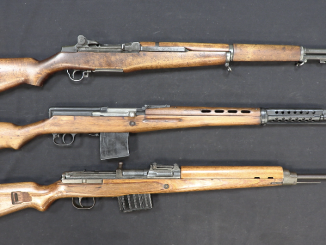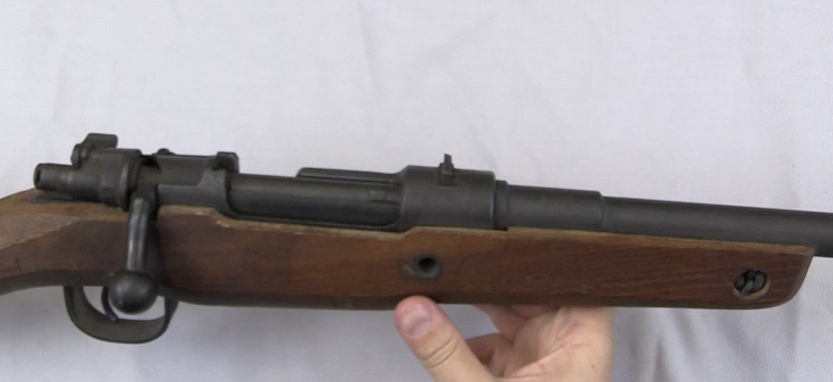Starting in 1909, Mauser had a plan to introduce a family of automatic pistols, with a picket gun in 6.35mm (.25 ACP) and a military/police service pistol in 9mm Parabellum that shared the same basic look. The initial 1909 prototype in 9mm was simple blowback, and proved to be a failure. The next attempt was a simple blowback 6.35mm, which was quite successful, and was marketed as the Mauser 1910, as well as the 1914 in .32 ACP (7.65mm). With that selling well, the company went back to its 9mm gun, and began experimenting with locking systems. After failing to get a vertically tipping locking block to work, they came to a flapper-delayed blowback system that was expensive, but worked well. That was the Model 1912, in 9x19mm.
Between 1912 and 1914 about 200 examples of this gun were made, with production standardizing by about serial number 50. Later examples were made for a military market, with 500-meter tangent sights and detachable holster stocks. Any hopes of challenging the Luger in Germany military service were dashed by the death of Paul Mauser in May 1914, coupled with the outbreak of war in August. The project fizzled to an end, and was never restarted after the war – although elements would go with Josef Nickl to Czechoslovakia and eventually show up in the CZ Model 27…
For more information on this and other Mauser handgun developments, I recommend “Mauser Pistolen” by Schmidt, Speed, and Weaver:




We see similar angled cuts in CMMG’s rotary delayed blowback system.
If you are pushing the flapper release up against, for example, a barricade, when firing is that a Bad Day?
“Delayed” should be referred as “Slowed”… There is no slowed slide action at these pistols… The slide seems rock solid when tried to be drawn… These guns are “Inertia Operating Locked Action”… The bolt between the flappers is the “ Inertia Mass” retaining its place when the pistol recoils and by means of which the flappers forcİng out of slide blockage…
The guns are real masterpieces but seeming unpractical for the pistol users used to draw the slide manually without actuating a lever which seeming a serious disadvantage under excited and frightening combat situations…IMHO…
You are picky with the words, Strongarm 🙂
How “resisted” would work for you? Say like police comes to pick you up and you spread your shoulders against door frame. Makes sense?
US patent. 1091857.
Denny, You may be right through the look of angled flappers locking surfaces but, angles are too slight and seem as been experimentaly found as a motion aid for moment convertion for the inertia block of rather small mass…
My sense is that there is very little space between flaps and centre block. Therefore there is no role of inertia in it. I imagine it was developed painstakingly, step by step. As it appears, it was not repeated ever after.
Sorry Denny but, The slide release latch also uses that space perfectly and unlocks the slide.
Besides, flappers with rotating axis remaining at the rear and under of a front applied force should be forced out nearly impossibly with a contact angle less than 45 degrees and further, if read the patent text, the unlocking effect of the inertia mass by recoil is described clearly and much further, at beginning the patent text the action is referenced to an earlier patent describing a recoil operated fixed barrel rifle with the same operation but flappers without angled contacts by cause of using inertia blocks of sufficient masses.
This is a handgun having no enough room for a bigger mass inertia block and it seems the angled flapper tips is provided to easining the unlocking action… IMHO…
Oh boy, were they serious? This is more fit for rifle than for pistol. But, the finishes are absolutely superb.
“(…)more fit for rifle than for pistol(…)”
Fine, then what you would say about 06-08, see 5th image from top
https://sportsmansvintagepress.com/read-free/mauser-rifles-pistols-table-of-contents/model-06-08-mauser-automatic-pistol/
?
You always find something new and interesting.
Don’t give him a swelled head
“(…)military/police service pistol in 9mm Parabellum that shared the same basic look. The initial 1909 prototype in 9mm was simple blowback, and proved to be a failure.(…)”
https://modernfirearms.net/en/handguns/handguns-en/germany-semi-automatic-pistols/mauser-1910-14-34-eng/ states that
In the year of 1909 they set to develop a new, relatively simple semiautomatic pistol, chambered for 9x19mm Luger ammunition with reduced load. This weapon, known as Mauser Model 1910, was not a great success; its updated version, known as Model 1910/12, was manufactured in small numbers under contract with Brazilian navy.
which lead to question about ballistic performance of this reduced load?
Delayed – make (someone or something) late or slow.
Everything is correct. The bolt rolls back at a slower speed than a straight blowback bolt of the same mass.
It is possible (as with MG42) that they found that under a certain combination of conditions, self-unlocking of the bolt occurs in a system with a short barrel stroke. All that is left is to get rid of the movable barrel and find the correct angle of the support surfaces.
I doubt this worked reliably.
Such a delayed system is not proportional. In a sense, the amount of delay does not have a proportional dependence on the power of the cartridge.
Add, common to similar schemes, sensitivity to the presence of grease and dust…
This should work even worse than the MP5.
Well, if it is just that bad, SMASH IT WITH A HAMMER to prove it’s worthless.
I like that safety; I know we now think of it as in the mag release position, but for a safety it is well placed… Easy release, after a positive engagement. Peronally I also like the auto slide release on inserting a mag= em2 like.
Actually…
Wonder if you could “hybrid” this and cross it with a Boberg… Niche market like; ze perfect pistol “he he”… Er maybe make the actual mag release a lower half only p7 type cocker position idea, bit stiffer like… Bit of maxim silverman cocking bit/but with a reverse falling block…
May mention this again, in a bit. Basics right though, sort of squished pistol; think brick… “But less negatively” he he.
Tap, tap, tappity tap; thinking.